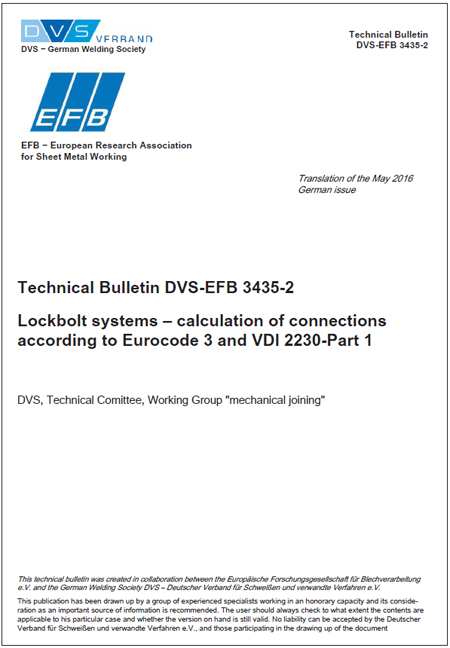Lockbolt systems – calculation of connections according to Eurocode 3 and VDI 2230-Part 1
This information sheet deals with the calculation of lockbolt connections under static and alternating stress. The following rules pertain to connections with individual sheet thicknesses ≥ 3 mm. The calculation method applied here relates to the connection with a single lockbolt. In calculations involving several lockbolts a realistic distribution of internal forces (forces and moments) must be assumed.
Here a choice may be made from a number of suitable calculation models.
The provisions of this information sheet apply to connections under shear loading and also to connections under tensile loading, which use lockbolts made of steel of strength classes 5.8, 8.8 and 10.9 according to DIN EN ISO 898-1 [1] and the corresponding collars. This information sheet also covers lockbolts and associated collars made of austenitic steel or aluminium. Values given in the tables apply to nominal diameters from 5 to 36 mm or from 3 /16" to 1⅜".
A lockbolt connection with the task of joining components together so as to prevent slipping or opening up must be preloaded. Preloading can be omitted if deformations (slipping or instances of opening) are acceptable up until the service load is applied.
Correct assembly of the lockbolt system using a suitable tool always results in a preload being input into the connection. Preloaded connections are usually produced with lockbolts made of steel of strength classes 8.8 and 10.9 and the corresponding collars.
In the case of shear stress the lockbolt connection is loaded perpendicularly to the bolt axis (shear connection), with axial stress the loading is along the bolt axis (tension connection) (see Figure 1). In the case of simultaneous action of axial and transverse forces an interaction verification must be provided.
This publication was prepared by a group of experienced professionals in voluntary collaboration and compliance with it as an important source of information is recommended. In all cases the user must check the extent to which the content is applicable to his own particular case and whether the version he is using is still valid. Any liability on the part of the DVS and those persons involved in preparing this publication is excluded.
The size of the nominal hole clearance is crucial in creating a connection with a normal hole clearance or a fi tted bolt connection. The tolerances of the bolt nominal diameter are not to be considered as opposed to those of the nominal hole diameter. Connections under shear loading can also be provided with a friction surface pretreatment at the contact surface.
Content
1. Purpose and scope of the information sheet
2. Basic design principles
2.1. Terms
2.2. Basics of force transmission
2.2.1. Connections under shear stress
2.2.2. Connections under tensile loading
2.3. General requirements of the design
2.4. Stress cross section lockbolts
2.5. Holes
2.5.1. Dimensions of holes
2.5.2. Hole diameter tolerances
2.5.3. Execution of holes
2.6. Lockbolt connection in single / double shear
3. Dimensioning connections with lockbolts
3.1. Rules for design in steelwork (according to Eurocode 3)
3.1.1. Categories of lockbolt connections
3.1.2. Preload
3.1.3. Hole spacing and edge distances
3.1.4. Shear connections
3.1.5. Tension connections
3.1.6. Combined shear and tensile loading
3.1.7. Verifi cation of fatigue strength
3.1.8. Design rules according to the directive for wind turbines
3.1.9. Supplementary rules and restrictions
3.2. Rules for design in mechanical engineering (according to VDI 2230-Part 1)
3.2.1. Stipulations for applying the rules according to VDI 2230-Part 1
3.2.2. Calculation steps according to VDI 2230-Part 1
3.2.3. Recommendations for application of the calculation steps
4. Listings
4.1. List of abbreviations
4.2. List of symbols
5. Literature
6. Calculation examples
6.1. Steelwork connections (according to Eurocode 3)
6.2. Connections in mechanical engineering based on VDI 2230-Part 1)

